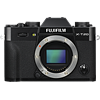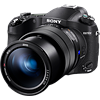Main
Model
Price
Advantages
launch
Announced
Body type
Camera subcategory
Sensor
Effective pixels
Max resolution
Sensor size
Sensor type
Processor
Image ratio w:h
Other resolutions
Sensor photo detectors
Image
ISO
Boosted ISO (minimum)
Boosted ISO (maximum)
White balance presets
Custom white balance
Image stabilization
Uncompressed format
Image stabilization notes
JPEG quality levels
Photography features
Minimum shutter speed
Maximum shutter speed
Maximum shutter speed (electronic)
Aperture priority
Shutter priority
Manual exposure mode
Built-in flash
Flash range
External flash
Flash modes
Continuous drive
Self-timer
Metering modes
Exposure compensation
AE Bracketing
WB Bracketing
Subject / scene modes
Screen / viewfinder
Articulated LCD
Screen size
Screen dots
Touch screen
Screen type
Live view
Viewfinder type
Viewfinder coverage
Viewfinder magnification
Viewfinder resolution
Videography features
Resolutions
File Format
Microphone
Speaker
Videography notes
Optics & Focus
Autofocus
Manual focus
Number of focus points
Lens mount
Focal length multiplier
Focal length (equiv.)
Optical zoom
Maximum aperture
Digital zoom
Normal focus range
Macro focus range
Physical
Weight (inc. batteries)
Dimensions
Environmentally sealed
Battery
Battery details
Battery Life (CIPA)
Storage
Storage types
Connectivity
USB
HDMI
Microphone port
Headphone port
Wireless
Wireless notes
Remote control
Other features
Orientation sensor
Timelapse recording
GPS
GPS notes
Samples
Videos
Summary
The X-T20 highest resolution of 6000 x 4000 pixels (24 megapixels) is better in comparison with the Cyber-shot DSC-RX10 IV maximum resolution of 5472 x 3648 pixels (20 megapixels). The X-T20 has larger sensor than the Cyber-shot DSC-RX10 IV: APS-C (23.6 x 15.6 mm) versus 1″ (13.2 x 8.8 mm). It is very significant advantage of this model as large sensor allows the camera owner to produce photos of the more professional quality. The X-T20 provides more number of focus points than the Cyber-shot DSC-RX10 IV: 325 vs 315. More focus points means more convenience while attempting to focus on objects which are not centred.
The Cyber-shot DSC-RX10 IV screen is better as it offers more number of screen dots 1,440,000 in compare to 920,000 dots of the X-T20 display. The higher dot count screen is better for reviewing pictures on your camera. The X-T20 offers better fastest shutter speed - 1/4000 second.
The Cyber-shot DSC-RX10 IV battery life is better than the X-T20 battery life. According to CIPA standards you will be able to produce 400 photos with the Cyber-shot DSC-RX10 IV and only 350 with the X-T20. The X-T20 weighs 383g that is 712g lighter in comparison with the weight of the Sony Cyber-shot DSC-RX10 IV. The X-T20 can utilize optional accessory GPS devices. Recording GPS data can be convenient if you like to travel, to be able to go into the photo metadata and see exactly where an image was captured.
Taking into account the above differences the X-T20 is the best choice. Check the list of the best offers on Amazon.


